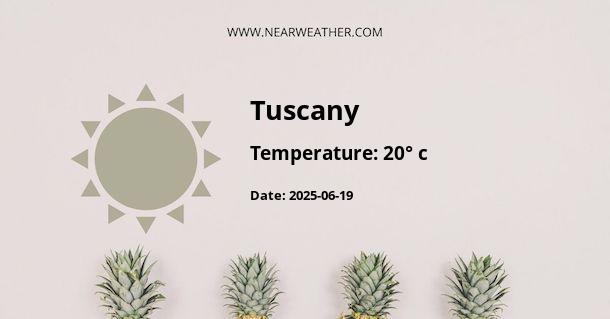Climate and Weather in Tuscany, Italy
Tuscany, located in central Italy, is known for its picturesque landscapes, historical cities, and rich cultural heritage. The region experiences a Mediterranean climate, characterized by hot, dry summers and mild winters. The climate in Tuscany is influenced by its geographical location and proximity to the Tyrrhenian Sea.
Seasonal Temperature and Rainfall
Tuscany experiences distinct seasons throughout the year, each offering its own unique charm and weather conditions. Here is a breakdown of the seasonal temperature and rainfall patterns:
| Season | Average Temperature | Rainfall |
|---|---|---|
| Spring (March to May) | 10°C to 20°C (50°F to 68°F) | 40mm to 80mm |
| Summer (June to August) | 20°C to 30°C (68°F to 86°F) | 10mm to 40mm |
| Autumn (September to November) | 10°C to 20°C (50°F to 68°F) | 70mm to 120mm |
| Winter (December to February) | 5°C to 15°C (41°F to 59°F) | 50mm to 100mm |
Spring in Tuscany is characterized by mild temperatures, blooming flowers, and occasional rainfall. Summer brings warm and sunny weather, with temperatures often reaching 30°C (86°F) or higher. Autumn is a pleasant season with mild temperatures and a higher chance of rainfall. Winter in Tuscany is relatively mild, with temperatures rarely dropping below freezing.
It's important to note that these are average temperatures and rainfall amounts, and there can be variations from year to year. It is always a good idea to check the local weather forecast before planning any outdoor activities or trips to Tuscany.
Microclimates in Tuscany
Tuscany is a region known for its diverse landscapes, which give rise to microclimates within the region. The coastal areas near the Tyrrhenian Sea experience a slightly milder climate compared to the inland areas. The Apennine Mountains that run through Tuscany also have a significant impact on the climate, with higher elevations experiencing cooler temperatures and more precipitation.
Popular cities in Tuscany, such as Florence, Pisa, and Siena, all have their own unique microclimates. For example, Florence has a continental climate with hot summers and cold winters, while Pisa has a milder coastal climate.
Best Time to Visit Tuscany
Tuscany is a popular tourist destination throughout the year, but the best time to visit depends on personal preferences and the activities you have planned. Here are some considerations for each season:
- Spring: Spring is a great time to visit Tuscany for those who enjoy milder temperatures and blooming landscapes. It is also a less crowded time compared to the summer months.
- Summer: Summer is the peak tourist season in Tuscany, with warm weather and longer days. It is ideal for outdoor activities, exploring the cities, and enjoying the beautiful beaches along the coast.
- Autumn: Autumn offers pleasant weather, with cooler temperatures and a chance to witness the stunning fall foliage. It is a great time to explore the countryside and enjoy wine tasting.
- Winter: Winter in Tuscany is relatively quiet, with fewer tourists. It is a great time to visit if you prefer cooler temperatures and want to experience the region's cultural attractions without the crowds.
It is worth noting that some attractions and businesses may have different opening hours or seasonal closures, especially during the winter months. It is always advisable to check ahead and plan accordingly.
Conclusion
Tuscany's Mediterranean climate offers a pleasant year-round experience for visitors. Whether you prefer the warmth of summer, the mildness of spring and autumn, or the tranquility of winter, Tuscany has something to offer. Its diverse microclimates and stunning landscapes make it a destination worth exploring in any season.
A - Tuscany's Latitude is 43.416672 & Longitude is 11.000000.
A - Weather in Tuscany is 3° today.
A - Climate Conditions in Tuscany shows clear sky today.
A - Humidity in Tuscany is 89% today.
A - Wind speed in Tuscany is 5 km/h, flowing at 37° wind direction. today.
